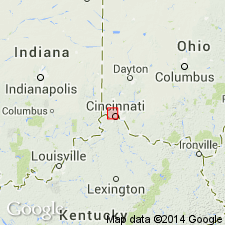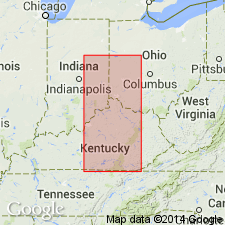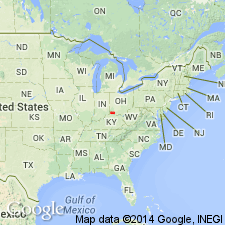
- Usage in publication:
-
- Grand Avenue Member
- Modifications:
-
- Named
- Dominant lithology:
-
- Limestone
- Shale
- AAPG geologic province:
-
- Cincinnati arch
Summary:
Named for Grand Avenue, Cincinnati, OH. Composed of shale and fossiliferous limestone. Limestone beds considerably thicker and more abundant than typical Kope Formation which lies above and below. 11 ft thick at type section. Occurs in upper part of Kope Formation.
Source: GNU records (USGS DDS-6; Reston GNULEX).

- Usage in publication:
-
- Grand Avenue Member*
- Modifications:
-
- Overview
- AAPG geologic province:
-
- Cincinnati arch
Summary:
Grand Avenue Member of Kope Formation adopted for use by USGS in KY and OH.
Source: GNU records (USGS DDS-6; Reston GNULEX).

- Usage in publication:
-
- Grand Avenue Member
- Modifications:
-
- Overview
- Areal extent
- AAPG geologic province:
-
- Cincinnati arch
Summary:
The Kope-Fairview-Bellevue succession is the first of three major progradational units that compose the Cincinnatian Series in the Cincinnati, OH, area. Each succession is interpreted as a mixed siliciclastic-carbonate ramp. The Kope Formation, consisting of approximately 80 percent calcareous and argillaceous shale and 20 percent coarse to fine-grained limestones and siltstones, is the most distal facies of the ramp complex. The Grand Avenue Member is recognizable along the Ohio River and consists of 3 to 4 m of interbedded shale and limestone similar to the overlying Fairview Formation. The Grand Avenue becomes indistinguishable 20 km to the north. Age is Late Ordovician (Edenian).
Source: GNU records (USGS DDS-6; Reston GNULEX).
For more information, please contact Nancy Stamm, Geologic Names Committee Secretary.
Asterisk (*) indicates published by U.S. Geological Survey authors.
"No current usage" (†) implies that a name has been abandoned or has fallen into disuse. Former usage and, if known, replacement name given in parentheses ( ).
Slash (/) indicates name conflicts with nomenclatural guidelines (CSN, 1933; ACSN, 1961, 1970; NACSN, 1983, 2005, 2021). May be explained within brackets ([ ]).

